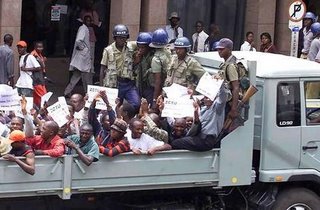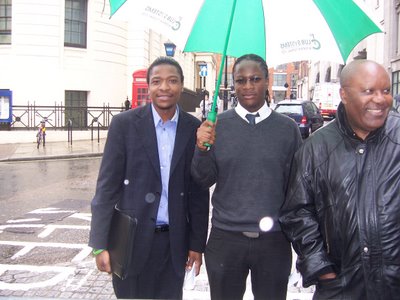MILITARISATION OF ZIMBABWE: Does the opposition stand a chance?
When Major General Vitalis Zvinavashe and Air Marshall Perence Shiri announced in March 2002 that;
"… let it be known that the highest office in the land is a straitjacket whose occupant is expected to observe the objectives of the liberation struggle. We will, therefore, not accept, let alone support or salute, anyone with a different agenda that threatens the very existence of our sovereignty, our country and our people."
It became clear that the military had diverted from its constitutional mandate into civilian politics. As we brace for another presidential election there are many questions we ask ourselves; is the 2002 threat not going to be sent out again? If it does what would be the consequences? How far anyway is the army involved in civilian politics? It is the objective of this article to explore the levels of militarization in Zimbabwe and probably give a prognosis of the future political climate.
In 1980, when Zimbabwe got its independence from Britain there were more than 65 000 fighters from ZANLA, ZIPRA and RSF who were waiting to be integrated into the Zimbabwe National Army whose capacity then was a mere 30 000. What it meant then was that there arose the need to demobilize and rehabilitate the other 35 000 soldiers. The first program Soldiers Employed in Economic Development (SEED) was a total failure. Later the John Shonhiwa led Demobilisation Directorate decided to award a package of $185 per month for two years to each demobilized soldier. A combination of factors like lack of financial discipline and proper investment training resulted in most beneficiaries reverting back to poverty within five years. Thus although the government had managed to integrate the 35 000 into civilian life most had to rely again on the same government for survival. The problem of poor demobilization program culminated in the War Victims Fund, the 1997 Gratuities and the 2000 farm invasion. Ultimately though, this program produced a crop of perpetual government dependencies who the government also symbiotically used and continues to use to sustain its cling to power.
At the height of the ZIPRA/ZANLA clashes between 1980 and 1987, ZANU PF created the Zimbabwe People's Militia which was typically a vigilante. It comprised of mujibhas and zvimbidos of the liberation struggle and the ZANU PF Youth Brigade. This branch was under the command of the Deputy Minister of Defence and at one point was trained by the notorious North Koreans infamous for the ruthless Fifth Brigade. It does not come as a surprise that ZPM has been implicated in the Matebeleland massacres of that time. The total number trained was estimated to be 20 000.
The government reintroduced the National Youth Service in the new millennium. The purpose of the training although the government claims is noble was specifically to consolidate power. The curriculum of the program involves basic military drills and at most the more advanced military ideology similar to that propagated during the liberation war. In 2005 Deputy Minister of Youth Development and Employment Creation Saviour Kasukuwere announced that 18 000 youths had graduated and absorbed by the government. Coupled to the ministerial objective of producing 6 000 graduates per year it extrapolates to about 30 000 graduates to date.
The Zimbabwe National Army and the Zimbabwe Republic Police have in total recorded a voluntary retirement of about 15 000 members since 1997.
What then do these figures mean to Zimbabwe? If you add up 35 000 war veterans, 20 000 ZPM, 30 000 from National Youth Service and 15 000 retirees we have a total of 100 000 civilians who have at least basic military education and training. This number, add 35 000 from ZNA, 5000 from Air Force of Zimbabwe, 25 000 from ZRP, 10 000 from Prisons and about 15 000 from CIO it means we have at least 190 000 people in Zimbabwe who have a basic understanding of military language!
At the level of leadership and policy-formulation there is need to also explore the level of involvement of the military in strategic entities that strictly deal with civilians. We have many cases, below are just some notable examples.
The Minister of Energy and Power Development is Rt Lieutenant General Mike Nyambuya. Rt Brigadier-General Ambrose Mutinhiri is the Minister of Youth Development and Employment Creation. Ministry of Transport has Rt Colonel Hubert Nyanhongo as Deputy Minister, whilst National Railways of Zimbabwe has Brigadier Douglas Nyikayaramba and Air Commodore Mike Karakadzai as Board Chairman and CEO respectively. At Grain Marketing Board there is Rt Colonel Samuel Muvuti as CEO. Permanent Secretary for Industry and International Trade is Rt Colonel Christian Katsande. Justice Chiweshe who leads the Zimbabwe Election Commission (ZEC) is a former Advocate-General in Zimbabwe National Army. The Attorney General Sobuza Gula-Ndebele is a Retired Colonel. Brigadier General Gibson Mashingaidze and Rt Lt Colonel Charles Nhemachena are both with the Sports and Recreation Commission.
What do these appointments mean to Zimbabwe?
Food (GMB) - ZANU PF controls
Transport - ZANU PF controls
Energy, fuel, Power - ZANU PF controls
Industry, Trade - ZANU PF controls
Sport - ZANU PF controls
Youth - ZANU PF controls
Attorney General - ZANU PF controls
Elections - ZANU PF controls
In the Joint Operations Command , there are Ministries of Defence, Finance, State Security, Home Affairs and Foreign Affairs. The military therefore controls the finances in one way or the other. Even the foreign policy is dictated by the military and not parliament, that's why there are a number of military men on diplomatic missions- Rt Major General Jevan Maseko in Cuba and Rt Brigadier Elsha Muzonzini in Kenya to name a few.
The question we pose to ourselves then is: in a country of nearly 200 000 military people, in a country whose public sector is run by the military, where does the common man fit? Is there a possibility of civil participation in the country?
This predicament compels one to pose and think of the state of the opposition in Zimbabwe. Where exactly on this well-oiled military setup can an opposition party hope to paralyse the system. Are democratic options in Zimbabwe feasible?
Can the civilians of this country go and impose their right to vote on an institution controlled by the military, funded by the military, run by the military, with the military fielding a military man (Commander-in-Chief) in the elections?
The picture does not look good yet I am compelled to commend MDC for struggling against the military with bare hands, NCA for provoking and outrunning the lion every day, Zimbabwe Lawyers for Human Rights for trying to prove how wrong the judge was for killing a man and prosecuting himself before acquitting himself, ZINASU for scaring the lion with the cover of a book and the whole of the civil society for standing up to the military junta. It is time to bury the hatchet and be one!
The Struggle Continues
Freeman Forward Chari
Secretary General
Zimbabwe Youth Movement







